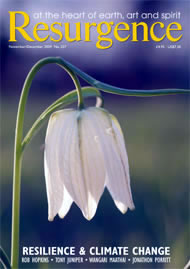Christmas Wreath
This naturally beautiful festive wreath is a far cry from the tinselly, trussed-up versions available in shops and markets, which are often so heavy on dark, gloomy greenery. It is also surprisingly fun and easy to make, and will be much admired on your front door for a good two to three weeks. For the cheapest, greenest and most natural effect, you would ideally forage your own foliage from garden or hedgerow – ivy in particular needs a good annual prune, so you’d be doing it a favour. Or you can buy it all in – it’s worth making an early-morning trip to a flower market and buying enough to supply a few like-minded friends, too. Why not get a few wreath-makers together for an informal workshop in your house? Fuelled by a simple yet delicious supper and a glass or two of mulled wine, much fun will be had and the wreaths will grow, like patchwork quilts, while you chat and work.
You will need
Whippy willow branches Trailing ivy Roll of florist’s wire Holly leaves Holly or other red berries Fir cones and mossy twigs Hydrangea head – the redder the better Strong ribbon or string for hanging
To make the wreath
1. Lay out the willow branches to the desired circumference for your wreath. Lay long strands of ivy on top of it and lash all layers tightly together with the florist’s wire to make a long sausage of foliage. This gives your wreath a good solid base and will help keep a strong round shape. (It’s possible just to use holly and ivy as a base, but you may find that the weight of larger wreaths will cause them to stretch into an oval when hanging.)
2. Form the sausage into a wreath shape and secure the ends together with wire. This makes the base of the wreath. Then, working around the wreath, attach holly leaves, berries, cones, twigs and sections from the hydrangea head, and any other Christmassy foliage, evenly around the circumference, securing each with the florist’s wire.
3. When you have gone round once, hang the wreath to view from a distance, and continue to add more leaves and berries if any part looks sparse. Attach a length of strong ribbon or string at the top back of the wreath where it will not show, for tying around a nail or hook on your door. The wreath should last a good three weeks if hanging outside and may even dry out sufficiently to carry on as an indoor decoration, to be supplemented with seasonal flowers and foliage, throughout the rest of the year.
Bag-in-a-Bag
Plastic carrier bags are a definite no-no in both the eco-conscious and the style stakes. But finding the right shopping bag – one that’s big and strong enough to carry heavy groceries, light enough to fold up small and fit in your handbag and stylish to boot – is like searching for the Holy Grail. The one featured here ticks all the right boxes, incorporating a gusset for extra capacity and a pretty ribbon and button tie for rolling it up small. It’s also surprisingly simple to make – choose from striped cotton canvas or pink metallic nylon for a touch of glamour.
You will need
1m (39") in any standard width of strong fabric that isn’t too thick or heavy; or use an off-cut measuring 64cm x 80cm (25" x 32") Cotton thread for machine sewing 20–30cm (8–12") ribbon A pretty button
To make the bag
1. Cut out a piece of fabric measuring 80cm x 46cm (32" x 18") – including a 1.5cm (½") seam allowance.
2. To make the straps, cut two strips of fabric, each measuring 54cm x 9cm
(21" x 3½"). Fold in 5mm (¼") on each side to the wrong side and iron flat.
3. Fold each strap in half lengthwise (so that the pattern is on the outside and the folded edges are facing inwards), and machine topstitch all the way along.
4. For the top edge of the bag, fold in one of the longer sides by 3mm (1⁄8") to the wrong side. Iron in place and then fold down a further 4cm (1½") and iron again.
5. Pin the two handles in place, beginning with handle one about 10cm (4") in from the right side edge. Pin one end of the handle, then pin the opposite end about 13cm (5½") away from the first end. Have the stitches on the inner side of the handles, and the bottom of the strap pieces level with the bottom of the folded-over edge of the bag.
6. Repeat at the opposite end with handle two. Secure the handles in place and stitch down the top of the bag with two rows of machine stitching, one about 3mm (1⁄8") from the top edge and the other along the bottom of the folded-over edge.
7. Fold the bag in half, right sides together. Sew the side and bottom seams about 1.5cm (½") in from the edge. Zigzag stitch over the raw edges to prevent fraying.
8. To make the gusset, open the bag out so the bottom seam runs down the centre and sew a diagonal line of about 10cm (4") across each corner.
9. To make the ribbon and button tie, loop the length of ribbon around one of the handles, joining and securing with a button. To roll up the bag, fold it into three or four sections and roll up, leaving the straps end until last. Then simply wrap the ribbon tie around the roll and wind the loose end of the ribbon around the button to secure.
Edited extract from Homemade: Gorgeous Things to Make with Love by Ros Badger and Elspeth Thompson, published by Collins, ISBN 9780007284795.








